#jonandbecky
Explore tagged Tumblr posts
Text
Photography and History
"How do you take such good pictures?" people often ask. "I have the latest Nikon. What lenses should I buy?" they enquire.
In 2016 I retired. Retired from a life behind the lens. A career that began working in a darkroom after school, working my way up through school to photographer for several magazines. A major Chicago catalog photographer and a Baltimore film and advertising director were also on my resume. Then on to Nashville to produce scores of shows and content for an extensive variety of clients.
My career had taken me around the world. I often say, "I've been to some of the most romantic places on earth... with a dang film crew in tow."
My wife's medical career had only allowed her to be with me on a handful of those trips. So when we retired, it was Becky's turn.
It was her initial idea to travel. A motorcycle trip through the backroads of Tennessee launched our desire to explore the roads less traveled. To scout the unique character of the countryside.
Our curiosities were piqued by what we saw in small towns and along byways. The people who occupied the front porch swings and drove tractors accross the fields. The John Deere hats that gathered in diners for bottomless cups of coffee and endless stories. People who live a life counter intuitive to our "city" paradigm.
There were also those markers... black and silver historical markers that stand, mostly unread along the way. Public history cast in metal, carved on stone, or embedded in resin telling stories of events not published in the history books and most assuredly of little interest to me back in junior high school. Some markers are factual and some boring, while others are cryptic, wierd, funny and downright bazaar. But most, like the John Deere hats, tell stories.
The richness of history is in it's local details, and has little significance on a global scale. Details that are told of massacres or hangings, a beloved stagecoach horse, a prospector who fell to his death with pockets full of gold; or just something interesting that happened nearby. History is not just about the high and mighty. It hangs in pictures on the walls of courthouses and in the local Elks lodge; in diners, saloons or local museums. It is etched in rock and caves by ancient prehistoric civilizations, found in the most remote wilderness.
So to the inquirer with the Nikon, the camera bag of lenses and filters, let me say this: It wasn't till I retired from the cameras, studios and production trucks, did I "get it." I started taking pictures of the things I loved. I found a new love.
Retirement for me means freedom. It means hiking, Jeeping and backpacking, in the most remote places in the country. Cameras, lenses and gak became a cumbersome burden.
The famous photographer Chase Jarvis once said “the best camera is the one that's with you.” You can argue that axiom if you see a bald eagle in a tree 300 yards away, and your smartphone is the one that is "with you." But at the age of 65, I sold and gave away more gear than most folks have ever seen. I was no longer a professional. I just took pictures... with only my phone.
But to answer the question, "how do I take good pictures?"
I put things I love in front of my lens.

1 note
·
View note
Text
Going For Five
Four years ago we began our journey, our journey to happiness, freedom, amazment and unbounded adventure. It took us about a year to realize that while National Parks, State Parks and tourist stops are full of splendor, they offer the traveler only a minute fraction of what lies on the blue highways, down dirt roads and up winding switchbacks. We discovered treasures lay cradled in narrow canyons cut by rapid waters, and magnificent mountains serve up stunning panoramic vistas of colorful textures. Streams cascade out of hills and form lakes fed by glaciers and crystal springs where native fish spawn and eagles perch on nests above. Microcosms of plants and ants feed foxes and bear, bees and elk.
Americans have developed for themselves less than 5% of this country and not a single person, not one, lives on 47% of US land. So it's no accident that we find solitude and substance in the remaining 53% left to us by inhabitants. 83% of the population live in urban areas, so again, little wonder we can easily avoid contact with all but a few people (a 2020 imperative.)
Nature has beckoned us to don our boots and backpacks and walk deeper and deeper into its magnetic beauty, while keeping us fit and healthy. Our 4-wheel-ability lets us begin those hikes where few have gone, giving us near exclusive access to what God has for us to see and explore.
In some ways we feel like modern day explorers... the Lewis and Clarks of the twenty-first century. We weren't taught this stuff in school, so it is new and fresh and ever so amazing to our eyes. John Lubbock, the father of archaeology said, “Earth and sky, woods and fields, lakes and rivers, the mountain and the sea, are excellent schoolmasters, and teach some of us more that what we could learn from books.”
Even before the pandemic, we found our isolation in nature. After our initial quarantine in the Arizona desert we headed for higher elevation leaving behind dear acquaintences with whom we resorted during the short winter months.
We replaced friendship with exploration. We have traded conversation with communion with nature. We opted to skirt national parks and tourist stops in favor of remote public lands. Isolated spots along rivers and lakes accessed by Forestry Service roads or Burea of Land Management areas. We have replaced hot tubs, margaritas and throw-back bands, with campfires, and the sounds of coyotes, and calls from moose and elk.
Our biggest gift is the freedom of time. Our clock, for the past four years, has been set to “discretionary” and our compass points in every direction. We can stay a week or day. We can, because as long as our health holds, we have adventure to propel us and a Home on Wheels to rest our head.
Jon and Becky Davis are full time adventurers traveling this magnificent country in a 40-foot Home On Wheels, (HOW.) Blue highways and back-roads are our roads most traveled. Our passion is Jeeping and hiking in places away from tourists and crowds and to enjoy what God made for us to explore.

#homeonwheels#jonandbecky#homeiswhereyouparkit#howrv#retireontheroad#hikingadventures#goingonfiveyears
2 notes
·
View notes
Text
Woodstock, 50 Years Later
Living in our HOW (Home on Wheels) for the past three years has been our ticket to amazing experiences. From rodeos to The Rose Parade, art museums to boat races, slot canyons to The Grand Canyon, we have done amazing things.
A year into our journey we planned to attend Woodstock 50, wherever it was to be. We reserved a spot for HOW at both Watkins Glen and the original location at Bethel Woods, knowing that eventually one would become the clear choice. As the event approached, everything went wrong for the Watkins Glen event. Michael Lang, who owned the Woodstock name, experienced withdrawals from promoters and artists, and never got ticket sales off the ground. Somehow, booking Jay Z, Chance the Rapper, Miley Cirus and hip-hop acts did not match our expectations of what a celebration of Woodstock should be. Rolling Stone quoted David Crosby’s take on Lang, “it had nothing to do with anyone feeling good about each other. It had to do with certain people making huge amounts of money.”

So, on the weekend marking the 50th anniversary of the greatest love-in music festival in history, we arrived at what seemed to be hallowed ground. The spot that was once Max Yasgur’s alfalfa field is now a beautiful venue for the arts and music, set in the pristine rolling meadows called Bethel Woods. Much has changed but the vibe was still there as an anticipated crowd of 100,000 passed through the gates in this four-day celebration, (far less than the 500,000 of ‘69.) Arriving early, we tail-gated for a while, had some wine and cheese and talked to folks who were adorned with tie-dye, beaded headbands, bell bottoms and peace-sign jewelry. Some arrived in their original restored VW buses. We met old hippies who were there a half century ago, as well as first timers. We were surprised how many young people there were. A blended mix of peace and love seekers of all ages. (pictures below)
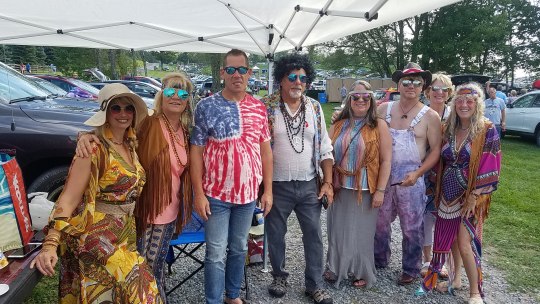
The first night we rented lawn chairs and sat on the hillside right behind the covered amphitheater on immaculately manicured grass. As the sun was sinking over the fields behind us, the stage lights illuminated Earth, Wind, and Fire as they took to the the stage playing: “You Made Me So Very Happy, Spinnin Wheel , And When I Die, and God Bless The Child. The band spanned all genres of pop, rock, featuring a new kid from American Idol, Bo Bice as frontman.
Next to perform was the biggest surprise of the night. Edgar Winter Band rocked the planet (or at least Bethel Woods) playing Tobacco Road, Frankenstein, Free Ride, Rock-and-Roll Hoochie Koo, and Dying to Live. Winter is a multi-instrumentalist but is acclaimed as the first person ever to put a neck strap on a keyboard and dance the stage with a Moog Synthesizer. The most remarkable performance was his vocal ability. He mimicked complex riffs and was answered by the lead guitar, bass player, keyboards and drums to the amazement of everyone in attendance.
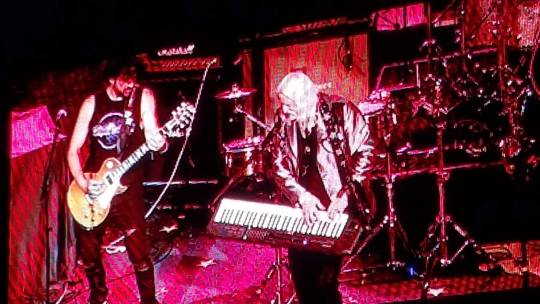
The stage fog increased, pounding bass notes vibrated and pulsed with intensity. Strobing, motion ellipsiodals, pars and dichroics traced through the sweet smelling, pot laced air, ushering in the headliner… Ringo Star and his All Star Band.
An extremely fit and young-looking Ringo Star danced to downstage center and the crowd responded in thunderous unison. Gobos painted peace symbols on the upstage scrims and familiar tunes echoed through the hills. The setlist was epic: It Don’t Come Easy, Boys, Hold The Line , Act Naturally, Matchbox, Down Under, The Weight, Anthem, You’re Sixteen You’re Beautiful and You’re Mine , Pick Up The Pieces, Work to Do, The No No Song, Photograph, and I Wanna Be Your Man.

Leaner and livelier than Ringo’s 79 years should allow, his message was peace and love, but his anthem was FUN. He did jumping jacks to Yellow Submarine that frenzied the crowd who responded by singing every word.
Ringo has surrounded himself with luminaries of Rock-and-Roll fame and his band reflects amazing talent. Colin Hay, the Australian singer-songwriter, guitarist and actor was lead singer for Men at Work. He displayed his talents on the keyboards, percussion, bass and lap steel.
Hamish Stuart of Average White Band has played with John Lennon, Chaka Khan, David Sanborn, Smokey Robinson and the list goes on. He led The All Star band with his signature hit Pickin’ Up The Pieces.
Vocalist, drummer Gregg Bisonnette who hailed from Van Halen, Santana and later Toto, joined Ringo to duet on the drums.
Guitar legend Steve Lukather was the original guitarist and vocalist for Toto and served in that capacity for the band’s entire existence. Steve demonstrated unbelievable licks throughout the entire set.
The Hammond organ has always given that unmistakable “goin-to-church” feel to R&B, rock and jazz. Keyboardist Gregg Rolie who sang for Santana and Journey made me want to yell hallelujah!
Warren Ham came to the All Star Band from the Maranatha Praise Band and toured with Promise Keepers. He also toured with Kansas, Donna Summer, and Olivia Newton-John.
Ringo’s encore finale electrified the audience with A Little Help from My Friends. People held hands and waved their lit phones above their heads. We left that night feeling a little more peace and love and ready for the next day’s events.

The next day was special as we were able to share it with our daughter, Kirby and Phillip. We had incredible preferred seating. We arrived early and were able to enjoy the venders, people watch, and stand in line to buy Woodstock tee-shirts.
I had mild expectations for Santana’s opening band. The Doobie Brothers, surprised us with their tight, amazing sounds and vocals. The band’s ability to evolve and remain connected to multi generations of audiences is a testament to their craft. Only two originals remain, Patrick Simmons and Tom Johnston, but they have added young progressive talent to their roster to deliver their unmistakable style of pushing the beat.
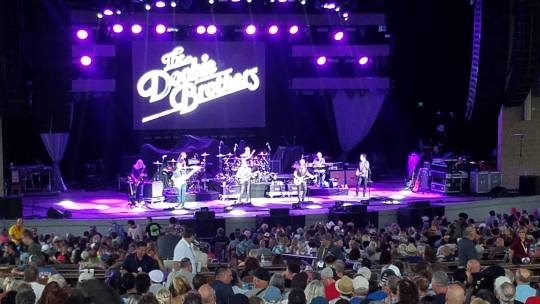
Dancing erupted and continued throughout the whole set as the Doobs belted What a Fool Believes, Listen to the Music, Takin’ It To the Street, China Grove, Black Water, Jesus is Just Alright, and possibly the most recognizable opening guitar riffs of all times, Long Train Runnin’.
But the headliner of all headliners was about to emerge from the green room. Santana began his set with dramatic video of Woodstock ’69, a documentary set to music that took you back to the chaotic days of Vietnam, Martin Luther King, Bobby and John Kennedy and the emerging peace movement. Santana, dressed in a black original Woodstock t-shirt and played his signature red guitar. Evil Ways, Black Magic Woman, Gypsy Queen, Maria Maria, Oye Como Va, and of course, Smooth had the crowd memorized and dancing in the isles. Carlos paid tribute to Lennon, Caltrain and Hendrix. The stage production, set design, lighting and sound were masterful. The energy level peaked and stayed there for three-and-a-half hours resulting in sensory fatigue for most of us, but a high we will never forget.
We left with the message of peace and love, sharing and caring which, I believe, has diminished in the past 50 years, when the sounds of Jimi Hendrix, Janis Joplin, Grateful Dead, Joe Cocker, and Crosby, Stills, Nash and Young echoed across the soggy fields known as Bethel Woods, the real Woodstock.
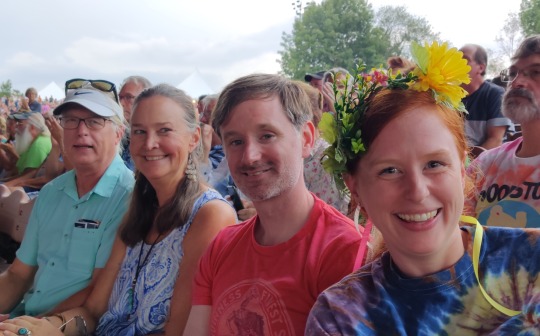

#homeonwheels#jonandbecky#retireontheroad#bethelwoods#woodstock19#homeiswhereyouparkit#nobodylivesbetter
2 notes
·
View notes
Text
Chapter 6: Fargo the Cattle Thief
For centuries cowboys have moved livestock through the plains, up and down the Continental Devide, from the mighty Mississippi to California and from the Brazos to the Rio Grand. Library shelves are lined with novels and historical fiction depicting cowboys and gun slingers, train robbers and horse thieves, bordellos, Comanches, Apaches and Crow.
A few days with Fargo was akin to speed reading volumes of Zane Gray, Larry McMurtry, Louis L'Amour with a smattering of Laura Ingles Wilder thrown in. When I was growing up cowboys were legends and here I was with my boyhood hero.
As a young cowboy Fargo went where there was work. He was in Montana when he and his buddy were offered fifty cents a head to drive cattle over to the Canada side. Fargo said no. The ante was upped to three dollars, but Fargo smelled a skunk. Something about these guys he didn't like. When the offer reached a lucrative five dollars a head, Fargo's partner weakened and made the deal.
Crossing over the border they were run down by the border patrol and charged with taking stolen cattle into Canada. After a night in jail and pleading mea culpa, the judge gave Fargo the choice of doing time or joining the Cavalry in Korea as a civil servant. He made the choice and took his first air flight to the other side of the world.
Fargo performed well in Korea shoeing mules and horses for the U.S. Cavalry. At night he would shoe the villager's mules for a little extra cash which he attributes to saving his life. He was particular about his farrier work making sure hoves were cleaned, trimmed and polished with brown shoe polish that he always carried in his supplies.
One time, he recalls, he and 2 soldiers were riding along a waterfront. They were ambushed and his two friends were shot off their mules and were killed. "The damn Gooks didn't kill me because they recognized me as the 'good shoer' from the village."
Later, he remembers, he was being transported with other troops and three crated mules in a C57 when the plane caught fire. He, being a civilian, had no parachute traning but was quickly harnessed and pushed out of the burning plane along with three crated mules. He found himself behind enemy lines with only two mules that survived the jump. The surviving mules began braying for the third mule who had met it's fate in the jump. Afraid the "Gooks" would hear the mules, Fargo rubbed shoe polish on their noses to quiet them. I assumed they were busied trying to lick it off. But it shut them up.
Crouching by a roadside, he finally heard English being spoken and saw a Jeep with US military personnel approaching. Boy were they supprised when an American kid with two mules came out of the bushes.

When he got back from the war he worked for the circus awhile. He respected the animal trainers and learned alot from them, but he had no use for the people who performed high wire acts.
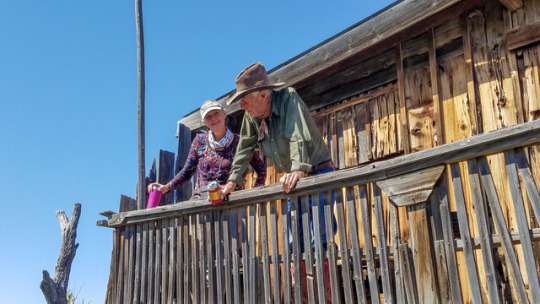
At one point in his life, Fargo joined the Texas Rangers and while he did not know Pancho Villa, he had respect for how Ole Poncho and General Pershing handled the Comanches and the "wet backs." Fargo showed us his Texas Ranger badge which was struck from a Mexican peso. He had several pictures of Poncho and his friend Edgar May, from his horse breaking days.
Becky and I sat and listened to Fargo as he told stories. If he couldn't recall he would look puzzled and tell you, "I don't remember," or "I can't recall." But if you asked a question that he had already covered, he would snap, " I already told you that dummy!" He did not hesitate to give you his opinion. He liked Paul Newman but thought Robert Redford was a brat. He liked John Ford, but told the story about when his Raven bit John's ear. He did not like Michael Landon of "Little House" but liked Hoss (Ben Cartwright) of "Bonanza.
He was not impressed with or did he care for Mike Wolf or Frank Fritz who visited The Ranch early in their career as American Pickers. He said that the two and their crew were not respectful.
Fargo is a man of strong prejudice and kind passions. There were questions we wanted to ask but felt there were times in his life he would rather not talk about.
Never have I felt like I struck a chord with anyone like I did with Fargo. He was the childhood hero that took me 60 years to meet.

2 notes
·
View notes
Text
The Beach
Only a few days of travel but an immense topographical difference from the rugged arrid mountains to this island sea shore where our HOW sits tucked in grassy dunes just yards from the churning surf. There are waves and ocean on all sides and the air is pregnant with a salty spray. Pelicans glide over the foam and choose their aquatic lunch in the surf while I sit below a rainbow colored beach-brella reading western historical fiction.
The beach feels, tastes and smells like vacation. It jogs memories of our two girls maturing from sand pails and shovels, to toe rings and boy friends. It marks a place where we invited close friends and closer family to enjoy our Grayton Beach house together.
Those "vacation days" were precious times. We savoured every second because they were limited by the "must returns" and the "gotta dos" back at our schools and jobs.
So here we are, on a different beach and a very different time. There are no "gotta dos" or "hafta-bes." The waves still pile up ready to crash ashore just like my memories of another time.
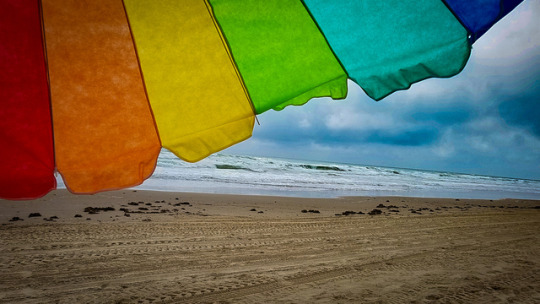
1 note
·
View note
Text
Fargo Chapter 7: The Farewell Fetish
Three days at the Museum Ranch. A walk through history. I am still scratching my head why Becky and I were singled out to spend three days with Fargo and his ranch hands Quattro and Barton. Was it, perhaps, that he felt badly for calling me a "goddamn, long hair, short pant wearing hippie?" Or was it that he sensed that this former film producer from Tennessee needed a few lessons about how real films were made? What ever it was, this is and always will be a high mark on our full-time adventure.
As we walked through the ranch there was one predominant item that hung on every door. They dangled from his truck mirror and his golf cart. They were on saddles and carriages and blowing in the breeze on fence posts. There was one hanging in sight no matter were we were. I had seen these feathers before in movies, around the necks of Indians and at gift stores that sold curios and moccasins in Cherokee, North Carolina. But I had no idea of their signicance. Fargo said they meant different things to different people but in general they were kind of like a good luck rabbits foot.

When telling a story, Fargo would refer to a person or practice as being either "good medicine" or " bad medicine." These feathers were "good medicine."
The last day of our visit, Fargo went to one of his two brown painted vintage refrigerators. Only one still worked and was stocked with cold beer. The other sat by his chair with his coffee pot on top. This one contained things he didn't want the pack rats to pilfer. He brought out a wooden box and several jars of bird feathers. In the box was twine, Elmer's Glue, scissors, some suede and red and blue yarn.

From the jars and coffee cans Fargo dug with intent, sorting through each feather till he found the perfect ones. "It has to be a left feather" he told Becky, "because the left feathers cover the heart."
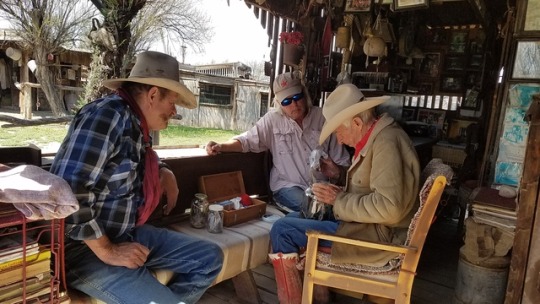
The first feather was small brown with distinct white polka dots. It was a Guinea Hen feather. He said he would use this one because Becky liked it and thought it was beautiful and Becky had a beautiful spirit. Next he pulled a pure white Dove feather once again from the left wing of the bird. He chose a Dove because he thought Becky was a quiet peacemaker and it fit her personality and the bird's. Next was still a larger feather of an Owl. He said I had the characteristics of this bird because I was wise and was a good bus driver. He said Owls glide along and are choosy and careful as they fool and attack their prey. They snatch them up quickly and devour only live animals. The last and final feather was a long and sleek black feather from his pet Raven of 21 years. He said Ravens were the cleverest and funniest of birds and were opportunist. He said we were like the Raven because we siezed every opportunity for adventure.
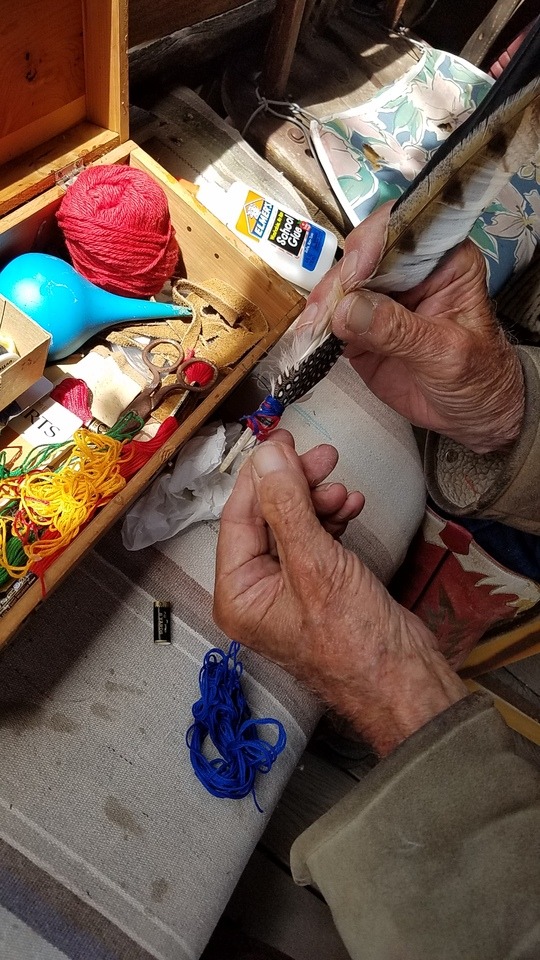
As he told the story of these birds he began to put together our fetish, gluing, tieing and wrapping each one with a piece of rawhide. Carefully making sure that it hung just right. He cut a piece of fence wire and twisted it just so into a hook then spray painted it gold, letting it dry in the wind. He presented us our fetish to hang in the windshield of our bus along with an invitation to return anytime.
There are many more stories, but my memory expires faster than I can enter my thoughts on my tablet. I'm sure after I close-out this final chapter I will think of more stories told by my friend Fargo Graham. But for now this chronicle is what I have to remember a man and his friends who lives 12 miles and a hundred years from town at The Museum Ranch.

1 note
·
View note
Text
Fargo: Chapter 5
Fargo has a deep respect and love for animals. He understands that thinking like them is integrally necessary to break and train them. In his rodeo days, he was a bronc rider and a rodeo clown. He loved to train broncs but proclaimed bull riding to be "stupid." He said to train a horse always lead them to water and their feed. Never feed or water them in a stall or in a corral. Soon they would think you are a pretty good guy and they will learn they like having you around. "But a mean horse," he said, "will always be mean. Get rid of it, don't try to fix it or give it to your wife, unless you want her to get kicked or bucked," he said, bobbing his hat up and down.
Through the years Fargo picked up enough auctioneer speak to auction cattle and horses for a while. He even demonstrated a bit of "cattle rattle" to Becky and me! He learned that horses and mules that were seized at the border and auctioned by the border police made very good pack animals. His theory was "the drug lords were not going to put all that expensive shit on a bad animal." Made sense to me.
Fargo provided pack mules to the park services, the ones they use to take supplies in and out of the Grand Canyon. Because he was the best in the business, he was asked to meet a long black limousine and take some VIP clients down the north rim to Phantom Ranch at the bottom of the canyon on the Colorado River. Stepping out of the limousine was Eva Gabor and her husband who he knew from "Green Acres" days. They had a fun few days together.
Barton and Fargo explored the bottom of the Grand Canyon where few if any have ever gone and have driven livestock all over the west. Barton explained that when they stopped for the night they would make a campfire and hobble one of their horses (using cuffs they placed on a horse's front ankles) and let the rest graze. He explained they could never carry enough hay for the entire herd but had 50 pounds of grain on one of their pack mules to encourage loyalty from the livestock. They would let the mules graze with the horses because the mules would fend off coyotes.The cowboy's bed roll consisted of blankets, quilts and a pillow. If it rained, they used a tarp. Coffee, beans and dried beef were the mainstays.
Coyotes and ravens are much maligned and misunderstood by ranchers, but were revered by cowboys as well as Indians. "Ranchers, " Fargo said, "often blamed coyotes for killing calves, but many times, calves would die at birth and the coyotes were just being opportunists." Fargo spoke of them as clown-like, admitting they could be quite playful and entertaining.
Once a director ordered a raven nest (holding a baby raven) to be removed from a windmill. Fargo threatened to shoot the director and climbed to the top and put the baby chick in a paper sack and kept it. The raven stayed by his side for 21 years and was an extra in several films. Fargo taught him to talk and the ranch hands taught him to cuss. One day Fargo drove to the end of the lane to get his mail with the raven perched on the back of the seat of his pick-up. It was mating season and there in the sky above the mailboxes was a flock of ravens. The pet raven took flight to join the other birds in the sky. Fargo yelled at the top of his voice for the bird to get the hell back in the truck. After calling him for several minutes the raven flew back and resumed his perch in the truck. What Fargo learned later was that his neighbors waiting to get their mailbox had witnessed the event. The news around town was that Fargo was some kind of sorcerer with the ability to call birds from the sky.
As Fargo sat and told his tales, eagles would swoop down as if to say hi and jack rabbits would enter the courtyard to eat the pellets that Fargo's chickens had left behind. Fargo taught Becky how to tell the difference in an American Eagle and the different hawks in flight. He had names for most of the game and fowl, and could tell them apart.
Fargo said, "Falcons have slender wings in comparison to their bodies. Hawk's wings are fatter and rounded and eagles have distinctly separated feathers on the ends of their wings." "Bald eagles" he said, "were rarer and that's why the Indians used their feathers for ceremonial use only. And they only use the feathers from the left side of the bird." When I took the bait and asked why, Fargo replied, "because it covers their heart, and yours, dummy!" he said as he once again made his Stetson jump up and down on his head.

Our Home on Wheels, (HOW for short) was now parked beside a fire pit where we sat, drank beer and waited for Becky to fix dinner, a pork roast glazed in pineapple, miso paste, maple syrup and bacon; some broccoli and sweet potatoes. He asked Beck what kind of meat he was eating and was told it was pork. He said he never eats pork, but admitted it was the best meat he had in years.

We talked about ranch brands and he let us burn our own brand into the bench by our HOW. The J Bar B.
The western sky was painted with purple, orange and deep blues behind a silhouetted windmill, signaling an end to another day at The Museum Ranch, 12 miles and 100 years from town


1 note
·
View note
Text
Fargo's Museum Ranch: Chapter 4
Visually, the ranch was pristine but weathered, much like Fargo. They both have withstood storms, and it showed. The twisting winds are brutal coming off the nearby Chiricahua Mountains. At one moment you see a sand storm in the distance, swirling tornados, ejecting white plumes high in the air. Then in seconds, the swirl overtakes you. There is no light. It is like someone ripped the sun from the sky and you are being blasted and tossed by sand at 40 to 60 mph. You are blinded. Becky and I have experienced such a storm driving our bus on I-10 in the New Mexican desert. The most terrifying 30 seconds of my life.
But the Museum Ranch stands as it has for decades, everything in its place choreographed by a master set director. There are a dozen or so sheltered gathering spaces (sitting areas) around the ranch. Each unique and all displaying memorabilia and photos of movie stars with their arms draped on the shoulder of a younger Fargo. These gathering spots are in the corner of barns, under carriage sheds, by fire pits, attached to a hen house or upstairs over a storage shed. In each one, there are places and porches to sit and talk. Some have a few chairs and benches, while others have a few metal milk crates turned on end, or maybe a log for us to straddle. But most notably, in every space there was a single armed chair with a padded seat were Fargo would hold court to a captive audience of us.
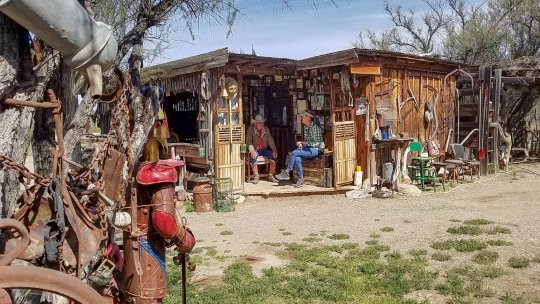
There was always music playing in the background. Radio set to a Mexican station or a phonograph player softly emitting vocals of Patsy Cline, Hank Snow, Rex Allen, and Ernest Tubb. Signature cowboy songs. A perfect underscore to match our cinematic imaginations, while Fargo told stories of the old west.
While Becky and Fargo were chatting, I was admiring a Stetson hat and removed it from a hook on a post. Barton was quick to tell me that I should "replace it like I found it" because if it were 1/8 inch off, or rehung askew Fargo would notice.
Fargo and his ranch hands each had a few trucks. Quattro even had a Cadillac. But all vehicles were stashed behind a grove of mesquite or under the back side of a shed, not distracting from the perception that we were back in the late 1800's. An electric golf cart was the only hardware that belied the visual genera. Fargo needed it's assistance to get around and check on things. He would fatigue quickly and often pulled out an inhaler from his jeans to allay coughing and breathlessness. But at 89, he was still leaner and keener than most of our friends just reaching retirement age.

We climbed aboard the electric cart and set out to see the ranch. He rode us to where stagecoaches and chuck wagons were stored. The one carriage with a large frame, Jonny Cash liked best. Quartto pointed out the chuck wagon used by Lee Marvin and Brian Keith in The Quest and Monty Walsh. There was the stagecoach Maureen O'Hare while swishing her petticoats climbed in and rode off, in Big Jake. He pointed out items used in McClintock, Butch Cassidy and the Sundance Kid, wagons from the Little House pilot, saddles and spurs from Three Amigos and yokes and harnesses that accompanied the mule teams in Bonanza. Most, he said, he had sold or left back in Old Tuscon where we visited last year. But he still had an amazing collection of important antiquities from the silver screen.

He called our attention to an old blacksmith's anvil. "That thing weighs 350 pounds," he said with half grin half grimace. "You know how I know?" To which I gave a shrug. "Arnold Schwarzenegger picked the damn thing up and told me," Fargo grinned, adding emphasis by raising his eyebrows up and down three or four times making his hat bob on his head.
Homing pigeons moved in and out of their roosts. Fargo explained how intelligent they were and their dependable characteristics. He supplied Old Tuscon with birds for many movies. So if you are watching an old John Ford western and you see birds a flight, they were probably trained by our friend Fargo to fly on cue.
Once he was commissioned to provide deer for a scene of the animals running through prairie. The scene was to be shot from above from a helicopter. However, the producers were prohibited from herding or using live game in a shoot. So Ole' Fargo rigged antlers on his goats, placed them at one end of a canyon and put Barton at the other end of the canyon with the pappa goat to call the "deer herd." The helicopter lifted off and the scene was captured in one take.
We headed down a fence line on the safe side of longhorn steer and bulls to a wood-hewn building with a cross on the front. Quattro hobbled in with us as we entered the chapel.
At the front, centered between two wood beams was a large print of the last supper, the one depicting the servant in the foreground. On the right was a pulpit draped in a colorful sarape blanket with two wooden slats tied in a cross on the front. Behind the pulpit was a statue of The Madonna and another cross above it. On the walls were Indian ceremonial feathers and bells, a menorah, a yarmulke, and plastic flower arrangements. Beside the pulpit was a photo of Mother Teresa and The Pope.

On the left side of the chapel was a firebrick altar with a leaded glass backdrop. A brass cross leaned against a wood mantle and two tin cups dangled below. Fargo retrieved a now extinct, Blue Diamond self-striking match from a Ball Jar, scratched it across the brick, and began lighting several candles. I was about to cross myself or genuflect when Fargo broke my reverence and uttered, "Yeah, I've got all kinds of religious shit in here. I've got Protestant shit, Catholic shit, Jewish shit, Indian shit, and we've even had a few weddings. Quattro there's a minister, and he officiates," gesturing to Quattro who was now standing behind the podium gripping both sides firmly.

Quattro, the minister, told us a little of his story while standing behind the pulpit. He had originated in Pensylvania and came out to Arizona to visit his brother at UofA in Tucson. He met Fargo on set at Old Tucson, fell in love with the west and never went back. He helped Fargo with the animals, worked as a bronc rider and stuntman, and fit into the movie business as Fargo's sidekick.
After blowing out the candles on the altar, we left the church and headed down the lane, opening and closing gates behind us. We drove onto open range where fifty miles of sagebrush, tumbleweed, and sand lay in front of the jagged Chiricahua mountains where we hiked just days before. We arrived at a clump of mesquite trees that shaded seven grave sites. We sat on benches and listened as Fargo told us stories about each ranch hand who was buried there. His words were kind with a deep appreciation for their service.

We carted back to the coffee pot area. It was 2 pm. Fargo moved his chair from in front of the padlocked door and opened it. The door swung inward to reveal a saloon right out of the movies. Four stools, a swinging door, and a bar lined with bottles of whiskey, bourbon, and tequila in front of mirrored glass. Hanging behind the bar were cowboy hats, Indian headress, scores of photographs, lanterns, spurs, feathers, beads and oh yes, an Indian scalp. I wasn't too surprised when he pointed out the spur marks in the oak bar top.
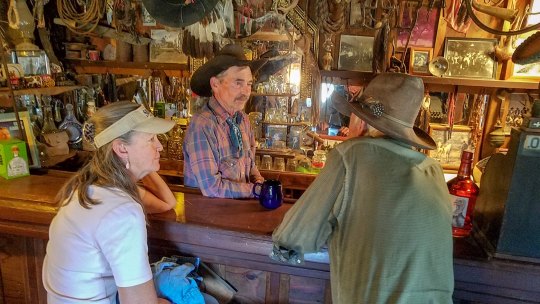

We looked through his stacks of 12-inch long-play records. An impressive collection. Becky chose Hank Snow and we enjoyed a few cold ones while Fargo told more stories of movies and the stars he knew.
We had spent the entire day with three of the most interesting men I've ever met. We learned more about animals, birds, Indians, history and movies, than I had in a lifetime. But this was just the first day of three. The next day we were to bring our forty-foot Allegro Bus (our Home On Wheels) and park right in the middle of The Museum Ranch, 12 miles and a hundred years from town.
1 note
·
View note
Text
Fargo The Kid : Chapter 3
As best we can figure, Fargo was born around 1939. His Scottish grandfather had laid claim to land that spanned upper Montana into Canada. When Taft ordered the 49th parrallel established, the ranch land was split, his family was granted duel citizenship and were able to ranch on both sides.
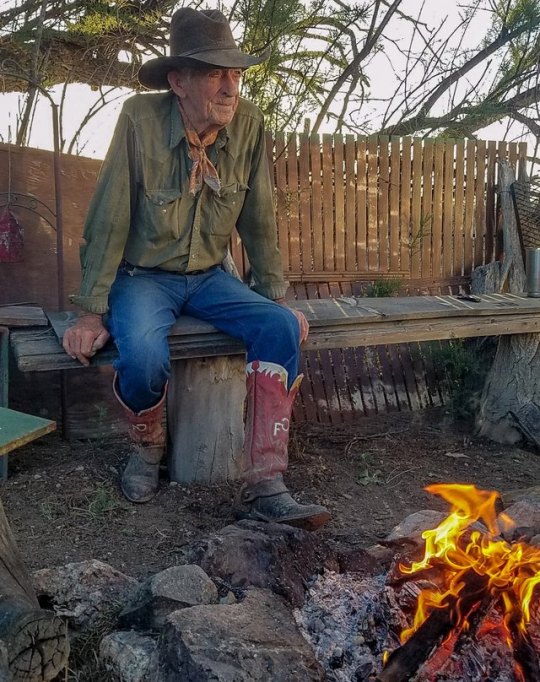
His mother was Blackfoot Indian and evidently Fargo had a rocky relationship with her that led to his running away from home somewhere around age 13. He did mention that later-on in his life she would visit him occasionally and would send him Stetson hats on his birthday. In a separate conversation, Quattro revealed that when Blackfoot Mom would arrive at the ranch, Fargo asked all ranch hands to leave. But his mother, evidently, was not the only woman for which young Fargo had a disliking.
As a young kid, Fargo loved horses and learned how to rope, ride, shoe, and train the equine on his father's ranch. He rode his horse twelve miles each way to a one room school house. His classmates also rode long distances as well.
He observed his teacher treating the horses in a way that disagreed with him. He, in-turn untethered all of the horses, set them atrot and rode off on his steed. Later, after an apparent parent-teacher meeting, his father decided it was time to send the wayward young Fargo to military school.
Learning the plan Fargo ran. He gathered provisions, a few pack mules two horses and snuck-out in the dark of night headed south, down the Continental Divide. He would stop along the way to ranch-hand or shoe horses and mules.

There were many dangers for a youngster in the wild wilderness, but Fargo developed the skills of reading situations and faces and knowing when he was in danger.
If he encountered rough people who wanted to take advantage he would back-track, make people think he was headed to his nearby home then continue on his journey toward Mexico.
He always woke up before sun-up (still does) and left without saying goodbye. He had uncanny horse sense, animal sense, and had learned survival skills and how to track people and animals from the Indians he met.
Fargo would hide his money in his saddle and carry some in his boot. This prompted Becky to ask if he used his saddle for a pillow, like in the movies. "Hell no!" Fargo exclaimed, "those damn movie directors don't no shit bout real cowboys. We always carried a feather pillow, blankets and quilts in our bed-roll."
He told us it was never a good idea to ride a horse across a river or stream. If necessary, he would losen or remove the bridle (horses can't breath and swim at the same time.) "Hang on to their tail or long rope and let them swim across. But it's best," he said, "to find a bridge or a shallow crossing." He was never happy when a movie director wanted to "swim" one of his horses or mules.
Two years after his departure from home, he met a lady who convinced him that he should let his folks know he was OK. He let her write a note and mail it back to Montana.

1 note
·
View note
Text
Why Nots
Our nomadic way of living affords us delightful opportunities. In our normal life (living in a sticks and bricks) we might drive to see our kids, go on vacation, spend a week or two at the beach house or even fly to New York and take in a few Broadway shows. But there was one caveat to going away… we had to return. There were yards to mow, plants to water and obligations and promises to be kept. No doubt about it, we enjoyed our work and our life, we enjoyed our obligations and commitments, but it was not till we started itinerant living did we realized the joy of “Why Not?” And the “Why Nots” have become the most wonderful part of our journey.
Recently we were ready to leave the Hudson River Valley and head west when a former Nashville colleague sent me a Facebook post that said “hey, come see us, we’re only 150 miles away in the Adirondacks.” A “Why Not” turned into a wonderful time exploring Lake George and getting to know friends whom I had known mostly on a professional level.
My thesis is this. We would never drive to Arizona just to see a village of ancient cliff dwellers, or travel to a border town, sit in a hot spring and judge a chili cookoff. We most assuredly would have never seen the Marfa lights or the Cody Stampede or been surrounded by bison on a lonely road. There would have been no picnics in a crater or hikes through a lava tube or vistas with friends we met along the way, none of this adventure, had it not been for “Why Nots. “
“Adventure is about what we do; not what we plan, strategize or dream about. Adventure begins with “what ifs” and “why nots.”
― Kevin E. Beasley, What If...Why Not? Through the Doors of Adventure
2 notes
·
View notes
Text
Sara's Crack
There is a magic of having some of America’s most iconic landscapes to call our backyard. Every day we see marvel producing sights. We gasp and cry “wow.” We exclaim how we wish for family and friends to see and feel what we experience. More than driving through a National Park and peering over the edge of a canyon on the way to another vacation destination, as wonderful that is, we seek out, savor, and inhale the obscure and unusual, places unreachable without maximum effort.

Yesterday we took a 5.2-mile hike down a river-wash through The Crack in The Mountain Trail known to the locals as “Sara’s Crack.” The scenic hike passes through one of the most famous slot canyons on the Lower Colorado. It ends at a breath-stealing cove beside balanced rocks that reflect into the emerald waters.

High clouds attenuated the sunbaked Arizona desert making it a perfect day to hike. Soon we realized why they call it Sara’s Crack. I’m not sure who Sara was but it was evident the she slid most of the way through the canyon on her own crack as we did. Along the way breathless hikers warned us not to return the yellow trail without tactical climbing gear. Gravity would assist our decent, but the return would require another trail up and over the narrow seam.

Life is about perspective. While in the slot, all we could see were walls of rock. With outstretched arms we could touch the sides of the daunting narrow crack in the mountain. The sky was only viewable with a strain-of-the-neck straight-up look. But on our way back we climbed the mountain and took pilgrimage to the top of that abyss. From there we could see emerald waters and rock formations painted with every pallet expanding as far as our eyes could see.

Edward Abbey wrote: “Yes sir, yes madam, I entreat you, get out of those motorized wheelchairs, get off your foam rubber backsides, stand up straight like men! like women! like human beings! and walk-walk-WALK upon our sweet and blessed land!”
1 note
·
View note
Text
Understanding the Risks
The trail is rated hard. The assent is steep and not well marked. Canyons close in, and our path winds through narrow drops, and over giant boulders. Cell phone coverage and GPS, unavailable. We are miles from the trail-head. We climb on.
With tires aired down we drive through miles of riverbed. We shift to 4-wheel-low and climb a banked grade of loose dirt. Pinned against our seat-backs we see only sky through our windshield before dropping down the other side, revealing a breathtaking Kodachrome valley with hoodoos, arches and table mesas. Another rewarding risk.
Four years back, we packed our clothes, sold our house and started a 450 horse-power diesel that would take us on a risky journey. A journey full of “what ifs” not supported by charts and not calculated by graphs with flattening curves.
There are those who believe that what we do is reckless. Perhaps if our journey could be calculated by a scholarly team of risk assessors, they might agree. These are the same people who tell me I cannot go to church, to a beach or a hair salon. They also tell me I’m in a high-risk group. To that, I say, “Hell yes, I’m high-risk!” For one, I’m old! Just a few short years from the actuaries’ expected lifespan, (another statistic they like to illustrate with a chart or graph.)
Only God has given me limits. He knows how many more beats my triple repaired heart will thump. He knows if I will leave this earth falling from a cliff or choking on a jellybean.
So, what the heck is risk?
Risk is something that charges my batteries. Risk is the adrenalin that pulses in my veins when I plant my trekking poles on a mountain top. Yes, I will wear a mask at home depot and carry my firearm on hikes. But I will not stop living my risky life to flatten anyone’s curve.
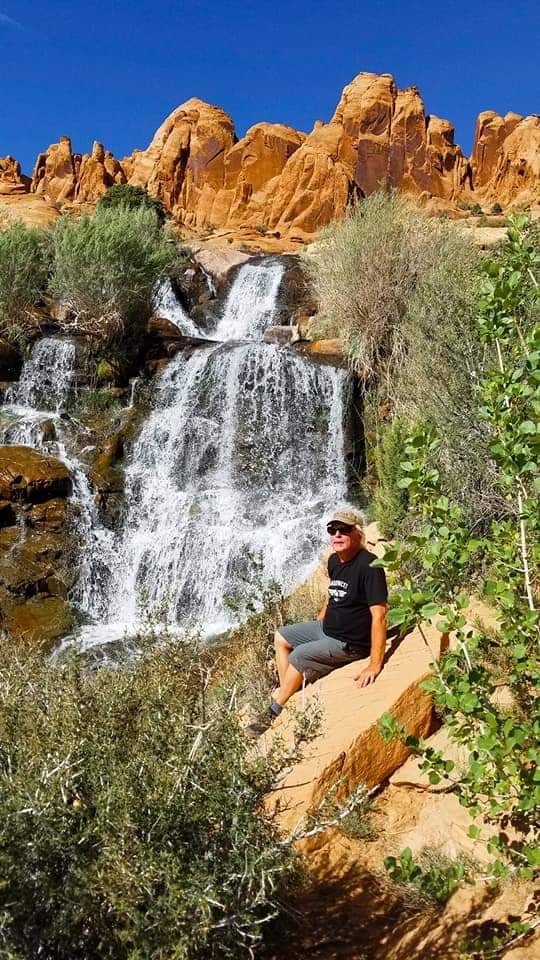
Jon and Becky Davis are full time adventurers traveling this magnificent country in a 40-foot Home On Wheels, (HOW.) Blue highways and back-roads are our roads most traveled. Our passion is Jeeping and hiking in places away from tourists and crowds and to enjoy what God made for us to explore.
0 notes
Text
Causeway Calamity

While in Destin, we stayed in one of the finest State Parks of our travels. Henderson State Park is situated on the beach with each site secluded by Sand Pines and Scrub Oaks. A short walk through the dunes put us on the sugary sand beach with vibrant aqua waters of the Gulf of Mexico. For many years we vacationed down 30A at Grayton Beach, so this area has always been our “go to” beach with great memories of sand pails, toe rings and shrimp salads. But with Christmas approaching we had to move along toward Gulf Shores where we are to spend Christmas with our kids who jumped at the chance to do Christmas on the beach.
We did our usual “pack up routine” and while I was tending to the grey water dump, Becky hooked up the Jeep. Our routine always includes checking each other to make sure the Jeep key is clicked to the first position, so the steering wheel is not locked, and both the crank case and gear shift is in neutral positions. Check and Double check! Well for some reason it was NOT double checked, or if it was, something got bumped.
We headed out across the causeway, a narrow two-lane bridge connecting Destin to Okaloosa Island. About half way across I looked at the monitor of our rear-view camera and saw smoke belching from the hood of our Jeep. We had to stop mid-bridge! Never mind, there was no shoulder, no place to pull over. I pulled our rig as close as possible to the low cement guard wall that separated us from the Choctawhatchee waters below. I had pulled so close that our door would not open enough to squeeze out. While the Jeep was spewing smoke signals for miles, I finally positioned the bus so I could shimmy out the door above the water below, while traffic swerved to miss our enormous footprint on the narrow bridge.
Our worst fears were confirmed as we looked under the hood and saw oil blowing out the top and bottom of four cylinders. Another check of the gear box found it was in third, allowing the engine to turn while it was being towed, without the benefit of a water pump and oil pump.
So here we are Ubering around Fairhope, AL waiting a week or two while our new engine comes in and the mechanic fits us in around his daughter’s birthday, holiday vacations and Hanukkah. Hopefully we will have a new engine and be on the road by the New Year.
We are trying not to let a $4500 mistake dampen our Christmas spirits. There are more important things. We are blessed with good health and a family who want to be with us at Christmas. So what the heck, Merry Christmas and Happy New Year to all.
2 notes
·
View notes
Text
Good and Evil
“Savannah is so beautiful that the dead never truly depart.” ― James Caskey
We crossed the Savannah River listening to the audio book, Midnight in the Garden. We docked HOW within sight of the black and white striped light house on Tybee Island. Shortly we had our toes in the sand and were sitting in a porch swing on the beach finishing the final chapter. The Book, as the locals refer to it, was an intriguing precursor for our next three days in Savannah.

The next few days were spent walking amid massive Southern Live Oaks dripping with Spanish Moss, and passing scores of National Landmarks. We visited Monterey Square and The Mercer House, where Jim Williams’ infamous companion was murdered.

We walked around Oglethorpe, Forsyth, Liberty and Lafayette squares, all with their own charm and bordered with shrines like The Cathedral of St. John the Baptist, Mickve Israel, Wesley Monumental and the birthplace of Juliette Gordon Low.

We visited the classic antiquity of the Owens-Thomas House, considered by architectural historians to be one of the finest examples of English Regency architecture in America. It is also on the “Ghost Tour.”

It seems that Becky’s nose for paintings on canvas always leads us to the most incredible works of art every place we travel. The Telfair Academy and the Jepson center were as good as it gets. With SCAD influence dotting most of the city, we enjoyed galleries of contemporary and the bygone.

The cobbled River Road paved a delightful night-time stroll along the Savannah River with river boats on one side, and shops, historic bars and eateries on the other.

Of course our visit would not be complete without visiting Bonaventure Cemetery. Interred among a most impressive assemblage of Live Oaks and Cyprus are the likes of Johnny Mercer, The Adlers, the Lawtons. the Aikens (the suicide/murder couple), Jim Williams and even Danny Hansford (read the book!)


Wherever we move our home we always meet locals. They become our new neighbors, albeit a brief encounter. Some we meet at bars, others at shops, on the beach or at eateries, but they all punctuate our journey with diverse opinions, lifestyles and information that cannot be Googled. They become our road-map and many will read our posts. This trip... a sail maker, a science teacher, a frame maker, SCAD students, and a restorer of fine art, all with stories that would fill volumes.
1 note
·
View note
Text
Blue and Green of Fall
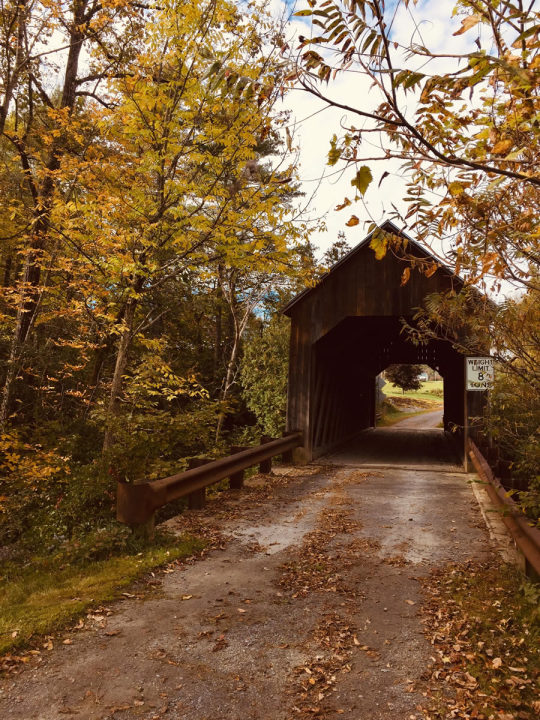
Beginning in September, fall hitchhiked with us from the covered bridges of Vermont and New Hampshire to the southern edge of Texas in December. We watched the migratory birds say farewell to Lake Champlain and imagined the very same birds catching up with us in the Adirondacks, escorting us along the Blue Ridge Parkway to the Tennessee River Valley and down the Mississippi. A palette of golden hues and reds followed us all the way to San Antonio.
Before Google Maps there were paper highway maps, you know the kind that was folded in a way you could never refold it back and your destination was always hidden in the torn crevice? On those maps the main roads were indicated in red and the back roads were always blue. Those blue highways, or “black tops,” are our highways of choice.
We avoid the interstate highways but seek out the big green areas indicated on Google maps. If you look closely, they occupy a massive footprint of our country. The blue highways, (state and county roads) thread their way through these big green spaces occupied by State and National Parks, National Forests, BLM lands, National Fish and Game Reserves and Native Reservations, all places we call home.
For the last three years we have crisscrossed the country from California to Vermont, and from the Upper Peninsula to the Texas Islands on these strands of blue. The Interstates that we avoid, connect spaghetti bowls of urban traffic and reroute America around the most wonderful gems, leaving once bustling mining towns, mills and merchant rich town-squares with dangling shutters and boarded windows. Even the fabled route 66 has been erased, abandoning iconic neon signs to blink in the dust.
But when you look beyond the broken signs and peeling paint of the once burgeoning towns you find faces weathered by experience, Fishermen and turners of the earth, live here. They congregate at lodges, diners and clapboard churches. They pick guitars and mandolins on porches and quilt in fellowship halls. There are no minorities here, it’s too small for that. Black, brown, red and white sit elbow to elbow on bar stools sharing stories of feed costs, little leagues and times before the plant closed. We find these people willing to include a stranger and invite us to a Christmas parade or a potluck. They tell us where we can get some good farm fresh pinto beans and when the boys are pickin’ across from the train station on Main Street.
These small towns, these folks are the tonic of our curiosity, our hero protagonists along the blue and green.
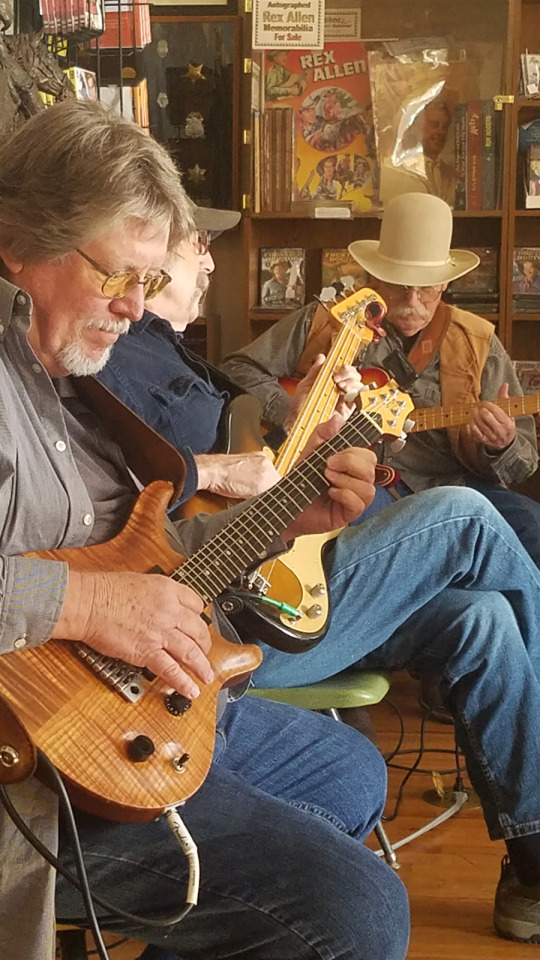
0 notes
Text
Fire onboard HOW
Tonight we were headed to our site outside of Savannah when we passed a Michelin man towering above a truck stop. Great, we thought, HOW needs tires rotated so why not spend the night amidst the trucks and be first in cue for a 7 am service. Now, staying in a truck stop is no different than staying in a resort. Once the shades are pulled, we could be situated anywhere and not know if we are parked at a Walmart, or on the beach.

We were both laying feet to feet on the couch reading Kindles, enjoying a glass of wine and debating what movie to watch, when the LP/ CO detector started shrieking.
Becky began opening windows, gathering esentials and throwing them in the Jeep, while I shut down the inverter and tried to figure where the smoke was coming from. A call to 911 quickly dispatched the Mettor, GA volunteer fire department away from their dinner and to our bus. After a thorough inspecting with infared heat detectors they found that our LP, CO device had caught on fire, burning the circut board inside and stinking up the bus with noxious fumes. The very device designed to allert us was the culprit.
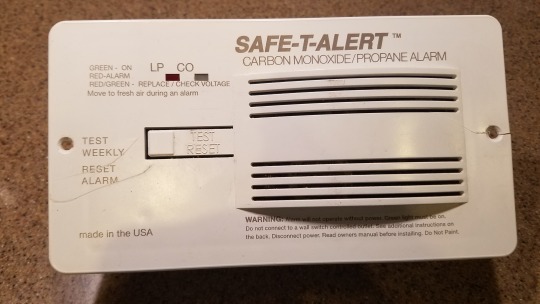
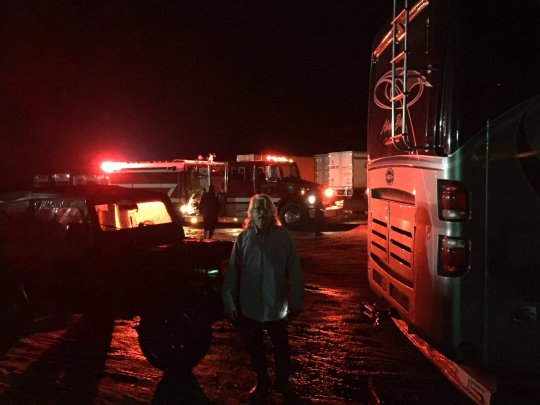
1 note
·
View note